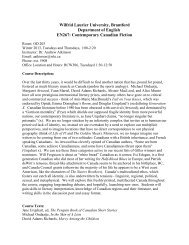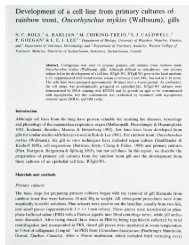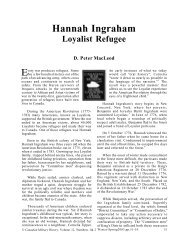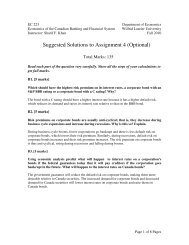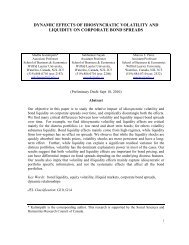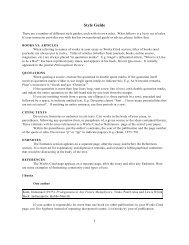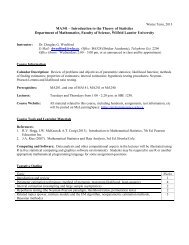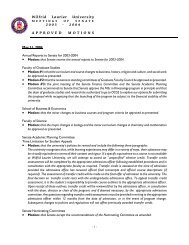Highlights of Better Beginnings, Better Futures See Our Research ...
Highlights of Better Beginnings, Better Futures See Our Research ...
Highlights of Better Beginnings, Better Futures See Our Research ...
- No tags were found...
Create successful ePaper yourself
Turn your PDF publications into a flip-book with our unique Google optimized e-Paper software.
GRADE12<strong>Better</strong> <strong>Beginnings</strong>, <strong>Better</strong> <strong>Futures</strong>AN EFFECTIVE, AFFORDABLE, AND COST-SAVINGPREVENTION PROJECT FOR YOUNG CHILDRENHIGHLIGHTS OF BETTER BEGINNINGS, BETTER FUTURESRESEARCH FINDINGS AT GRADE 12
universalholisticecologicalcommunity-basedintegratedIMPORTANT TERMS RELATED TO THE BETTER BEGINNINGS PROJECTBETTER BEGINNINGS IS…UniversalPrograms are made available to all children livingin the community, not just those singled out asbeing most in need or at risk. An advantage <strong>of</strong>universality is that it avoids drawing unwantedattention to individual young people.Holistic or ComprehensiveThe programs aim to support all aspects <strong>of</strong> theyoung person’s development and well-being(including relationships, feelings, skills, actions,and physical health), not just one or two aspects(such as physical health or IQ).EcologicalThe approach pays attention to the wholeenvironment surrounding the young person.Community-BasedParents and volunteers in the neighbourhood areinvited to participate in planning and evaluation<strong>of</strong> programs which meet the needs <strong>of</strong> their community.This ensures that the project is ownedand operated by the community, not driven fromthe “top” by academics and bureaucrats whichis typical <strong>of</strong> many other projects.IntegratedOrganizations and service agencies alreadyworking in the community are brought on boardto cooperate with planning, so that <strong>Better</strong><strong>Beginnings</strong> is <strong>of</strong>fered in conjunction with existingprograms. This characteristic is also referred toas “value added” and is in contrast to programsthat are “standalone.”Communities wishing to establish programssimilar to <strong>Better</strong> <strong>Beginnings</strong> would need to incorporateall <strong>of</strong> these qualities to ensure success.
ECOLOGICAL THEORY:UNDERSTANDINGTHE INFLUENCESON CHILDREN’S LIVESThere are different levels <strong>of</strong> influence,potentially helpful or harmful, on ayoung person’s development.INTRODUCTIONINTRODUCTION<strong>Better</strong> <strong>Beginnings</strong>, <strong>Better</strong> <strong>Futures</strong>An effective, affordable, and cost-saving prevention project for young childrenIN THIS BOOKLET, WE ARE PRESENTING AN OVERVIEWOF RESEARCH GATHERED FROM AND ABOUT GRADE 12STUDENTS WHO PARTICIPATED IN BETTER BEGINNINGS,BETTER FUTURES PROGRAMS WHEN THEY WERE IN JUNIORKINDERGARTEN THROUGH GRADE 2.WHY “PREVENTION”?Some <strong>of</strong> the kids and teens in our society donot have the same starting point as others. It isnot surprising that challenges in the family anddifficult conditions in the neighbourhood, notto mention lack <strong>of</strong> optimal government policies,can cause setbacks in their development andwell-being. As a result, many young people,especially those in disadvantaged communities,are in need <strong>of</strong> support along the way to preventthem from having increased difficulties as theylive, learn, and grow. <strong>Better</strong> <strong>Beginnings</strong> programshave attempted to combine the basic ingredientsneeded to provide such supports.WHY BETTER BEGINNINGSWAS CREATEDThe 1983 Ontario Child Health Study revealedthat 1 in 6 children had serious emotional orbehavioural problems. The report also showedthat children living in families that received socialassistance or who lived in subsidized housingwere at greater risk for these problems.If you picture the young person at thecentre, the levels <strong>of</strong> influence can bedescribed as moving outwards, similarto nesting boxes that fit one inside theother. The outer layers consist <strong>of</strong> parentand family influences, community andneighbourhood influences, and broaderinfluences from society. <strong>Research</strong>ersrefer to this nesting pattern as ecological,because it pays attention to the wholeenvironment surrounding the youngperson. This way <strong>of</strong> understanding childdevelopment is called ecological theoryand was first described by the socialscientist Urie Bronfenbrenner.Ecological theory was very importantto the planning <strong>of</strong> <strong>Better</strong> <strong>Beginnings</strong>,<strong>Better</strong> <strong>Futures</strong> and is the reason whyits programs are intended to addressmany levels that influence youngpeople’s lives, including their own wellbeingand success at school, theirparents’ skills and relationships withtheir children, and the neighbourhoodatmosphere and conditions.SOCIETYCOMMUNITYPARENTYOUNGPERSONPARENTSOCIETYCOMMUNITYSOCIETYHIGHLIGHTS OF RESEARCH FINDINGS AT GRADE 12
INTRODUCTIONTHE SITES AND PROGRAMSFrom 1993 to 1997, when the childrenwere aged 4 to 8, programs were<strong>of</strong>fered at the three chosen <strong>Better</strong><strong>Beginnings</strong> sites, namely Sudbury,Cornwall, and Highfield. These siteswere matched with two comparisonsites in Ontario that were similar tothem in terms <strong>of</strong> economic conditions,community characteristics, and otherfactors. These two sites, in Ottawaand Etobicoke, did not have <strong>Better</strong><strong>Beginnings</strong> programs and were usedby researchers to compare outcomesin the <strong>Better</strong> <strong>Beginnings</strong> sites.Each <strong>of</strong> the three <strong>Better</strong> <strong>Beginnings</strong> sitessupported the cultural identities <strong>of</strong> itsyoung people. Thanks to the inventiveness<strong>of</strong> the planning by program staffand parents, fostering cultural diversityis a hallmark <strong>of</strong> the <strong>Better</strong> <strong>Beginnings</strong>approach.<strong>Our</strong> previous <strong>Highlights</strong> Report onGrade 9 findings contains informationabout the dawn <strong>of</strong> <strong>Better</strong> <strong>Beginnings</strong>,its goals, the cultural characteristics<strong>of</strong> the sites, and descriptions <strong>of</strong> theprograms provided for the young people,their parents, and the community.The Grade 9 Report may be found at:http://bbbf.queensu.ca/investinginourfuture.htmlIt should always be remembered that<strong>Better</strong> <strong>Beginnings</strong> was not designed tosee which specific programs contributedto positive outcomes for young peopleand their parents and communities.Instead, <strong>Better</strong> <strong>Beginnings</strong> was designedto examine the sum total <strong>of</strong> the elements:universal, holistic, ecological,community-based, and integrated.THE GRADE 12 RESEARCHQuantitative research, based on interviewquestions which call for “yes” or “no”answers, numeric answers (such asheight and weight), and answers chosenfrom a range <strong>of</strong> fixed answers such asfrom “strongly agree” to “strongly disagree,”was conducted with 626 young peopleand/or their parents.Qualitative research was conductedwith two smaller groups <strong>of</strong> young people,one involving focus groups and interviews(36 youths) and the other just interviews(96 youths), using open-ended questions- for example, those beginning withHow…, When…, Why…, or Tell meabout... Questions were asked in aneutral way, so that participants werenot influenced in their responses.We provide results <strong>of</strong> quantitativeand qualitative research in this<strong>Highlights</strong> Report.Note: Only those findings considered to bestatistically significant are presented in this<strong>Highlights</strong> Report. Statistically significant meansthat the results shown here have at least a 95%chance <strong>of</strong> being true and not due to chance.The National Crime Prevention Centre,Public Safety Canada, provided thefunding for the Grade 12 research.THE ECONOMIC ANALYSIS<strong>Better</strong> <strong>Beginnings</strong>, <strong>Better</strong> <strong>Futures</strong>provides the first economic analysis <strong>of</strong>a Canadian early childhood preventionstudy. In this <strong>Highlights</strong> Report, wereveal how much was saved in directcosts to government by the <strong>Better</strong><strong>Beginnings</strong> program.2BETTER BEGINNINGS, BETTER FUTURES
THE YOUNG PERSONIN 2007, ONE-ON-ONE INTERVIEWS WERE CARRIED OUTWITH YOUNG PEOPLE FROM THE BETTER BEGINNINGS ANDCOMPARISON SITES AS PART OF THE GRADE 12 QUANTITATIVERESEARCH. THESE INTERVIEWS WERE CONDUCTED FOR THEMOST PART IN THE HOME, ON THE BASIS OF A QUESTIONNAIREBOOKLET, A COPY OF WHICH WAS PROVIDED TO THE STUDENTFOR REFERENCE DURING THE INTERVIEW.Youth Special Education ServicesAdjusted Percentages252015105013%Youth Reported15%Ministry Reported<strong>Better</strong><strong>Beginnings</strong>Sites19%Youth Reported23%Ministry ReportedComparisonSitesDichotomous Variable; 0 = Not Received,1 = ReceivedA lower percentage <strong>of</strong> youths from the <strong>Better</strong><strong>Beginnings</strong> neighbourhoods reported committingproperty <strong>of</strong>fences than youths from thecomparison sites (29% vs. 40% respectively).THE YOUNG PERSONMEASURES:WHAT INFORMATIONWE GATHEREDThe young people were asked about theirfeelings (emotional functioning) and relationships(social functioning), including how much socialsupport they had from the people around them,number <strong>of</strong> close friends, ability to clear up disagreementswith their parents, and experience<strong>of</strong> depression.They were also asked about their physicalhealth, weight and height (to check for healthyweight), physical activity, and health risk behaviours,including alcohol, cigarette, and drug use.Information was collected from the young people,but also from Ontario Ministry <strong>of</strong> Education records,about their success at school, including specialeducation services used, high school gradesattained, number <strong>of</strong> school suspensions, andwhether or not they graduated from high school.Youths were also asked a series <strong>of</strong> questionsregarding possible criminal activities such asbelonging to a gang and involvement in propertydamage, drugs, robbery, and assault.RESULTS:WHAT WE FOUNDA higher percentage <strong>of</strong> youths from the<strong>Better</strong> <strong>Beginnings</strong> sites reported engagingin regular exercise (81%) than youths fromthe comparison sites (72%).The average grade <strong>of</strong> young people from the<strong>Better</strong> <strong>Beginnings</strong> sites (75%) was higher thanthat <strong>of</strong> youths from the comparison sites (73%),based on their most recent year in high school.A lower percentage <strong>of</strong> youths from the <strong>Better</strong><strong>Beginnings</strong> sites used special educationservices while in high school than youths fromthe comparison sites. The data were relativelyconsistent from youth and Ministry reports:13% versus 19% based on information fromyouths and 15% versus 23% based on OntarioMinistry <strong>of</strong> Education records.Youth Property Crime29%<strong>Better</strong><strong>Beginnings</strong>Sites40%ComparisonSitesDichotomous Variable; 0 = Not Committed,1 = Committed67% <strong>of</strong> the original families from the three <strong>Better</strong> <strong>Beginnings</strong> sites wereinvolved in the Grade 12 quantitative research.63% <strong>of</strong> the original families from the two comparison sites were involvedin the Grade 12 quantitative research.Adjusted Percentages403020100HIGHLIGHTS OF RESEARCH FINDINGS AT GRADE 12 3
YOUTHS’ STORIESQUALITATIVE RESEARCH WITH THE YOUTHThe portion <strong>of</strong> the research which involved the collection <strong>of</strong> qualitative informationwas carried out through focus groups and one-on-one interviews. This sort <strong>of</strong>research encourages young people to reflect on their experiences and expresstheir feelings and opinions in their own words.Close RelationshipsBy Grade 12, young people’s peers, andadults in addition to their parents, have becomepart <strong>of</strong> their ecological circle <strong>of</strong> influence.These relationships can be important in preventinginvolvement in crime.Group interviews (known as focus groups) and some individual interviews wereheld with a total <strong>of</strong> 36 young people representing the five sites. Information wasgathered about their experiences <strong>of</strong> crime, their ideas about crime prevention,and their community “narratives” or stories about both.One-on-one interviews were conducted with 96 young people in which theywere asked to talk about three key life experiences: (1) a turning point in their lives;(2) their lifelong participation in community programs, including <strong>Better</strong> <strong>Beginnings</strong>(while aged 4 to 8) and school-required community service; and (3) their experiences<strong>of</strong> community life, including involvement, neighbourhoods, and crime.FROM THE FOCUS GROUPS…HOW YOUNG PEOPLEDESCRIBE CRIMEGiven that in 1991 the <strong>Better</strong> <strong>Beginnings</strong> andcomparison communities were chosen onthe basis <strong>of</strong> similar socio-economic disadvantage,it is relevant to look at experiences<strong>of</strong> crime <strong>of</strong> young people at all the sites.Here is one youth’s description <strong>of</strong> the crimein the neighbourhood.The drug and gun violence, I mean there’s likepetty theft every once in a while, nothing big,we haven’t had a murder in our neighbourhoodfor quite a while now, so, there’s nothing big likethat. It’s just basically like drugs just taking overmost <strong>of</strong> the time. You go downstairs and thekids have to be in at a certain time because youdon’t want them outside too late because theysee certain things.YOUTHS’ IDEAS FORCRIME PREVENTIONThe youths’ suggestions for and criticisms<strong>of</strong> crime prevention actions were aimed atthe different ecological levels described inthis booklet: the young person, their closerelationships, and the broader community.The Young PersonYouths discussed personal qualities thatprevented them from being involved incrime, and behaviours they used to preventthemselves from becoming victims.I think all that matters is who you are surroundedwith, because if you’re surrounded with peoplefrom a bad environment or that are alwaysgoing to put negative thoughts [in your mind],I think that’s going to affect you more than youhaving self-discipline towards yourself.The Broader CommunityYouths suggested solutions that broughttogether community members, schools, andeven police, including such projects asNeighbourhood Watch, an increase in socializingwithin the community, employmentagencies, and “organized-time” activities likeafter-school programs and sports. Theyalso, however, acknowledged some <strong>of</strong> thesuggested programs’ more serious drawbacks.For example, Neighbourhood Watch mightactually be ineffective because <strong>of</strong> people’s fears<strong>of</strong> the consequences <strong>of</strong> being a tattletale.You lose respect for yourself. If someone found out that I stabbed someone [thisis just an example], they would lose total respect for me, I probably wouldn’teven have any friends, because <strong>of</strong> it…Even my neighbours, would be sketchy[uncomfortable] living besides someone who stabbed someone…There’s justcertain things that you know not to do and if you do them, you sit back and yousay, what was I doing, that’s not who I am. …You have to live with yourself after you’ve done that. You have to live with whatyour parents or your friends think.4BETTER BEGINNINGS, BETTER FUTURES
FROM THE INTERVIEWS…TURNING-POINT STORIESAlthough qualitative research gathers informationfrom participants in their own words, it isstill possible to rate responses numerically. Forinstance, young people’s turning-point storieswere given a numeric score based on: howspecific or detailed the story was, whether theyouth’s emotional state changed from thebeginning to the end <strong>of</strong> the story, how well theturning point was resolved or taken care <strong>of</strong> inthe end, the personal growth that the youthexperienced, how meaningful the story was forthe youth, and how clear and organized theyouth’s story was. We found that in all <strong>of</strong> theseareas except the first, <strong>Better</strong> <strong>Beginnings</strong> youthstold significantly more positive stories thanyouths from the comparison sites.Turning-Point ResolutionThe figure below shows how the <strong>Better</strong><strong>Beginnings</strong> and comparison sites comparedin terms <strong>of</strong> how well youths’ turning-pointstories were resolved.How well youths’ stories were resolvedThe following quotations reveal that thosewho participated in <strong>Better</strong> <strong>Beginnings</strong>told turning-point stories that were moreresolved at the end than were stories toldby comparison participants.These are the words <strong>of</strong> a <strong>Better</strong> <strong>Beginnings</strong>youth:I remember in grade 10, I came down with anillness... I was out <strong>of</strong> school for 3 months...I wanted to live life like there was no tomorrowso after I got better I still didn’t go to school.But then I remembered all the sports that I hadand that helped me turn back to getting backinto school... I realized that I wanted to get agood education... sports helped me turn backon track towards my future... if I could do that,the world can’t stop me now.This youth’s comments about having gottenback on track with a view to the future andwhat was learned show that this event hasbeen sorted out and the young person iscontent with the conclusion.A comparison-site youth told this story:There was an incident at home, Children’s Aidwas called so I had to move to a centre forpeople with anger problems... then I got kickedout <strong>of</strong> there and went to a group home in[another city]... there were a lot <strong>of</strong> insaneincidents up in [that city]... one time, someonenext door got busted for marijuana...Everywhere you go, you’re going to seesomebody getting jumped, somebody gettingmugged, or people fighting... but I met somegood people...I think it was a wrong idea movingback from there. Because I had a bettereducation up there...now that I moved backfrom [that city] everything has changed... all myfriends are gone, everybody’s gone so I’m justkeeping on the down low, I’m not getting intotrouble anymore.This story shows some resolution, becausethe participant has learned from experience inthe other city to stay out <strong>of</strong> trouble. However,although no longer getting into trouble, theyoung person is not happy being home,leaving the story somewhat unresolved.Clearly, the story <strong>of</strong> the <strong>Better</strong> <strong>Beginnings</strong>youth is more resolved than the story <strong>of</strong> theTHE YOUNG PERSONcomparison youth.<strong>Better</strong> <strong>Beginnings</strong> Sites3.46Comparison Sites3.091.0 1.5 2.0 2.5 3.0 3.5 4.0Adjusted MeansHIGHLIGHTS OF RESEARCH FINDINGS AT GRADE 12
THE PARENTRESULTS:WHAT WE FOUNDFewer <strong>Better</strong> <strong>Beginnings</strong> parents were consideredto be clinically depressed (18%) than comparisonsiteparents (27%).Parent Clinical Depression3027%25THE PARENTAdjusted Percentages20151018%PRIVATE ONE-ON-ONE INTERVIEWS WERE CARRIED OUT ATHOME WITH PARENTS FROM THE BETTER BEGINNINGS ANDCOMPARISON SITES AS A PART OF THE QUANTITATIVERESEARCH. OF THE FAMILIES INVOLVED IN THE STUDY, 28%WERE SINGLE-MOTHER FAMILIES. IN THOSE FAMILIES WITHTWO PARENTS, IT WAS UP TO THE FAMILY TO DECIDEWHICH PARENT WOULD BE INTERVIEWED. THE RESULT WASTHAT 95% OF THE PARENTS INTERVIEWED WERE MOTHERS.MEASURES:WHAT INFORMATIONWE GATHEREDA number <strong>of</strong> questions were asked to find outwhether parents appeared to be influenced in apositive way by the <strong>Better</strong> <strong>Beginnings</strong> programs.Information was collected on parents’ physicalhealth, including permanent health problems andweight problems (based on a ratio <strong>of</strong> weight toheight), and both positive health behaviours(regular exercise) and negative health behaviours(smoking and alcohol consumption).’’Questions were posed about parents’perceptions <strong>of</strong> the social support around them,how well their family members got along (familyfunctioning), and how happy they were in theirmarriage (marital satisfaction). They were alsoasked about their social life (social functioning)and their feelings (emotional functioning),particularly their feelings <strong>of</strong> depression. Neitherthe interviewer nor the parent herself knewwhether or not her responses indicated clinicaldepression at the time <strong>of</strong> the interview. In thisway, the parent’s privacy was protected. Allparents were provided with a communityresource booklet at the end <strong>of</strong> the interview.If a specific kind <strong>of</strong> help was requested, theinterviewer helped identify the relevant section<strong>of</strong> the booklet.I would go down to my friend’s house down the street, [and] my dad wouldwatch me walk [there]. He’d stand outside the driveway and watch me walkuntil I would get there, just for safety. And I’m happy he did that.a Grade 12 student remembers50<strong>Better</strong><strong>Beginnings</strong>SitesComparisonSitesDichotomous Variable; 0 = Not Depressed,1 = Depressed; a score <strong>of</strong> 22 or more consideredto be clinically depressed.Parents from the <strong>Better</strong> <strong>Beginnings</strong> sites reporteddrinking alcohol less frequently than parents fromthe comparison sites.Also, although there were no differences inparents’ rates <strong>of</strong> smoking in <strong>Better</strong> <strong>Beginnings</strong>versus comparison sites, fewer <strong>Better</strong><strong>Beginnings</strong> parents (25%) than comparison-siteparents (33%) reported that there was at leastone other smoker in the home.At Least One Other Smoker in FamilyAdjusted Percentages3530252015105025%<strong>Better</strong><strong>Beginnings</strong>Sites33%ComparisonSitesDichotomous Variable; 0 = No, 1 = Yes6BETTER BEGINNINGS, BETTER FUTURES
RESULTS:WHAT WE FOUNDTwo measures showed more positiveoutcomes associated with the <strong>Better</strong><strong>Beginnings</strong> neighbourhoods.Parents from the <strong>Better</strong> <strong>Beginnings</strong> sites ratedtheir neighbourhoods as more cohesive.THE COMMUNITYParent Sense <strong>of</strong> NeighbourhoodCohesion20THE COMMUNITYONLY THOSE YOUNG PEOPLE AND PARENTS STILL LIVING INTHE ORIGINAL BETTER BEGINNINGS AND COMPARISON SITESWERE INTERVIEWED ABOUT NEIGHBOURHOODS AS PART OFAdjusted Means15101615THE QUANTITATIVE RESEARCH (ABOUT 260 FAMILIES IN TOTAL).MEASURES:WHAT INFORMATIONWE GATHEREDQuestions were asked to assess the degreeto which youths and their parents felt activelyinvolved in the neighbourhood, how satisfiedthey felt with the community, and how muchdrug use, violence, and theft they perceivedin their local neighbourhood (this is describedas deviance).Parents’ and youths’ sense <strong>of</strong> neighbourhoodparticipation and involvement (cohesion)was assessed using a series <strong>of</strong> five statements(for example, “I feel like I belong to thisneighbourhood” and “I feel I am importantto this neighbourhood”).Regarding neighbourhood deviance, parentsand youths were asked about the frequency <strong>of</strong>five “deviant” neighbourhood activities: alcohol,marijuana, and hard drug use, violence, and theft.Also, for youths, information was collected asto whether or not they had met the communityservice requirement established by the OntarioMinistry <strong>of</strong> Education.5<strong>Better</strong><strong>Beginnings</strong>SitesComparisonSites5 item scale; higher score indicates higher cohesion;range 5 to 20; respondents living outside BBBFsites excluded.As well, <strong>Better</strong> <strong>Beginnings</strong> youths viewed theirneighbourhoods as safer, less deviant placesto live than did comparison site youths,in terms <strong>of</strong> drug use, violence, and theft.Youth Perceived NeighbourhoodDevianceAdjusted Means54321450<strong>Better</strong><strong>Beginnings</strong>SitesComparisonSites5 item scale; higher score indicates higherdeviance; range 0 to 15; respondents livingoutside BBBF sites excluded from analysis.HIGHLIGHTS OF RESEARCH FINDINGS AT GRADE 12 7
’’THE COMMUNITYQUALITATIVE RESEARCH ON THE ROLE OFCOMMUNITY PARTICIPATION IN PREVENTIONYoung people from both the <strong>Better</strong> <strong>Beginnings</strong> and comparison sites had positivethings to say about their participation in organized community activities (many aspart <strong>of</strong> their school-required community service).[I learned] a lot through the [multicultural festival]. I’m a person that loves different people…Most <strong>of</strong> my friends are different cultures … it’s different, it’s interesting actually to know howthey live, to see the difference from your own [culture].It was nice to meet girls my age...that were nice girls, I mean they didn’t do drugs. Theyweren’t mean girls. They didn’t judge me. We were all really good friends. There was onegirl in that group that was handicapped and we were all good friends with her. No judgingwithin the group.I had done my community hours at an old folks home by doing activities with them andI absolutely loved it so I decided to go on to personal support worker. And I think I’mgoing to go on to either maybe nursing or just jump right in and just do this.I’d say [participating in the community settings] definitely made me grow as a person.I’m much more mature; able to understand the world a little more and how the world works.I felt proud <strong>of</strong> myself, really happy with what I did because I was able to kind <strong>of</strong> give backfor [what others did for me]…I just feel…it’s gotta work both ways type <strong>of</strong> thing. In orderto be successful, I think everybody needs to help each other out.A close analysis <strong>of</strong> statements by the youngpeople, however, suggested that those fromthe <strong>Better</strong> <strong>Beginnings</strong> sites had participated morein community programs throughout their lives thanhad the youths from comparison communities,and that their participation had resulted in agreater impact in their lives in terms <strong>of</strong> prevention,by encouraging healthy behaviours andimprovements in feelings <strong>of</strong> well-being.YOUTHS’ STORIESABOUT COMMUNITYWe also asked youths to talk about other waysin which they are involved in their communities,beyond the community service required byschools. In these stories, <strong>Better</strong> <strong>Beginnings</strong>youths in all three sites talked about being apart <strong>of</strong> their community in ways that providedmore detail than comparison youths. Moredetailed stories highlighted overall how youths,parents, teachers, and schools interconnectto create community. Youths told stories thatillustrated times when their community hadinfluenced them to conform or to change theway they act, resulting in greater group cohesion.Another important aspect <strong>of</strong> communitythat <strong>Better</strong> <strong>Beginnings</strong> youths discussedmore than comparison youths was emotionalattachment to a group and <strong>of</strong>ten this seemedto develop through informal social interaction,highlighting the role that fun plays in developingyouths’ sense <strong>of</strong> community. Overall, youthnarratives supported the view that the <strong>Better</strong><strong>Beginnings</strong> program created youths’ positivesense <strong>of</strong> community.BETTER BEGINNINGS, BETTER FUTURES
•ECONOMIC ANALYSISBETTER BEGINNINGS PROVIDES THE FIRST ECONOMICANALYSIS OF A CANADIAN EARLY CHILDHOOD PREVENTIONSTUDY. GIVEN THAT FUNDING FOR PREVENTION ANDINTERVENTION PROGRAMS IS SCARCE, ECONOMICEVALUATION CAN BE A USEFUL TOOL FOR INFORMINGPOLICY-MAKERS AS TO WHETHER A PREVENTION PROGRAMIS A GOOD USE OF SOCIETY’S LIMITED RESOURCES.Does prevention pay? Can an ounce <strong>of</strong>prevention avoid (at least) an ounce <strong>of</strong> cure?More specifically for public policy purposes,is there credible scientific evidence thatfor each dollar a legislature spends on“research-based” prevention or early interventionprograms for youth, more than adollar’s worth <strong>of</strong> benefits will be generated?If so, what are the policy options that <strong>of</strong>fertaxpayers the best return on their dollar?Steve Aos and co-authors,Benefits and Costs <strong>of</strong> Prevention andEarly Intervention Programs for Youth(Washington State Institute for Public Policy, 2004)ECONOMIC ANALYSISOVERVIEW OF OUR ANALYSISEconomic benefits <strong>of</strong> government-funded programsare typically divided into three categories:• benefits to program participants (e.g.,increased income from improved education),• benefits to non-program participants(e.g., reduced costs to crime victims), and• benefits to government/taxpayers(e.g., decreased special education costs,decreased costs to the justice system).The <strong>Better</strong> <strong>Beginnings</strong> economic analysis isfocused on benefits to the government/taxpayers.We refer to this analysis as a cost-savingsanalysis because it calculates how much governmentcost was saved as a result <strong>of</strong> the <strong>Better</strong><strong>Beginnings</strong> programs. We consider our calculationto be a conservative or modest estimate,because it considers only direct savings togovernment and excludes projected or likely futuresavings to government, such as the potentiallong-term savings that could result from keepinga youth from our program from a life <strong>of</strong> crime orfrom a future period <strong>of</strong> time on welfare.Many <strong>of</strong> the outcomes that result in significantcost savings do not begin to occur until childrenare in their mid-to late teens. That is whyan economic analysis <strong>of</strong> <strong>Better</strong> <strong>Beginnings</strong> is<strong>of</strong> interest at Grade 12.Of 19 childhood programsanalyzed in terms <strong>of</strong> cost-benefitsby Steve Aos and co-authors,10 resulted in long-term financialbenefits that <strong>of</strong>fset initial programcosts. Of these 10, however, onlythree yielded economic benefitsto government/taxpayers, and thevalue <strong>of</strong> these benefits relativeto program costs was very small.SOCIETY : mass media•COMMUNITYvalues • social policyPARENTvalues •PARENTYOUNGPERSONSOCIETY : mass media •economics •COMMUNITYHIGHLIGHTS OF RESEARCH FINDINGS AT GRADE 12 9
ECONOMIC ANALYSISFROM 1993 TO 1997…BETTER BEGINNINGSPROGRAM BUDGETThe expenses <strong>of</strong> the <strong>Better</strong> <strong>Beginnings</strong> programs for childrenaged 4 to 8 years and their parents from 1993 to 1997included staff salaries and benefits, materials for educationaland recreational activities, and food for snacks and smallmeals. An overview <strong>of</strong> ways in which spending was dividedup at the different sites is provided in the economic analysissection <strong>of</strong> the Grade 9 <strong>Highlights</strong> Report.VOLUNTEERISMTo a great extent, the programs at the sites were volunteerdriven,especially the management and planning committees,which included many parent volunteers – although someparents were given paid positions. The involvement <strong>of</strong> parentsand other community volunteers in program developmentis a key ingredient <strong>of</strong> the <strong>Better</strong> <strong>Beginnings</strong> approach,because community members are best equipped to knowthe needs <strong>of</strong> their young people and to make suggestionsrelated to programming.DIRECT COST PER FAMILYThe average annual budget from 1993 to 1997 wasapproximately $580,000 per site (therefore, $580,000 x 3 sitesx 4 years). Funding to cover this budget was provided by theOntario provincial Ministry <strong>of</strong> Community and Social Services,Ministry <strong>of</strong> Health, and Ministry <strong>of</strong> Education and Training.The programs were <strong>of</strong>fered to each child in JuniorKindergarten to Grade 2 and their parents at the <strong>Better</strong><strong>Beginnings</strong> sites for a total <strong>of</strong> four years. Over the course <strong>of</strong>the project, some <strong>of</strong> the families moved away from the sitesbefore they received all 48 months <strong>of</strong> programs. The directcost per family for participation from 1993 to 1997 is calculatedby determining the total number <strong>of</strong> months <strong>of</strong> participation<strong>of</strong> all the children and dividing the total program budget by thisnumber <strong>of</strong> months to arrive at a cost per family per month.The cost per family per month is then multiplied by the number<strong>of</strong> months in which each family participated in <strong>Better</strong><strong>Beginnings</strong> programs and then an average overallcost per family is calculated.The figure $2,991 represents the averagegovernment allocation per family over the years<strong>of</strong> program participation and exposure.BETTER BEGINNINGS, BETTER FUTURES
FROM JUNIOR KINDERGARTENTO GRADE 12…WHAT INFORMATIONWE GATHEREDFrom the time when the children were first inJunior Kindergarten to when they were in Grade12, the <strong>Better</strong> <strong>Beginnings</strong> <strong>Research</strong> CoordinationUnit gathered an increasing amount <strong>of</strong> informationannually from the young people and theirparents about contact with publicly-fundedmedical, educational, and social services(by 2007, information about contact with 19services had been gathered).Each time a person comes into contact withone <strong>of</strong> these services, it costs the governmenta specific amount <strong>of</strong> money. This amount wasmultiplied by the number <strong>of</strong> times the parentsor youths had contact with each service toestablish a cost amount for each person fromthe <strong>Better</strong> <strong>Beginnings</strong> sites compared to thosefrom the comparison sites.Costs associated with overweight and obesitywere calculated on the basis <strong>of</strong> another studywhich established costs to government servicesper adult with one <strong>of</strong> these weight conditions.Therefore, the savings gained in the19 public agencies more than coversthe $2,991 cost per family amount for<strong>Better</strong> <strong>Beginnings</strong> programs. To date,<strong>Better</strong> <strong>Beginnings</strong> is saving the governmentapproximately $4,569 per family.DID BETTER BEGINNINGS SAVE THEGOVERNMENT/TAXPAYERS MONEY?TRACKED CONTACTCOST PER BETTERWITH SERVICES SAVINGS BEGINNINGS FAMILYHEALTH SERVICES(Y+P: youth and parent contact) (Y: youth contact only)Number <strong>of</strong> serious injuries(defined as those requiring treatment) (Y) No $ 26 moreVisit with a nurse practitioner (Y+P) No 9 moreVisit to a family physician (Y+P) No 1 moreEmergency room use (Y+P) No 313 moreNumber <strong>of</strong> overnight stays in hospital (Y) No 871 moreBeing overweight (Y+P) Yes 39 lessBeing obese (Y+P) Yes 114 lessSavings in Health Services No $1,067 moreEDUCATIONAL SYSTEM (youth contact)This cost-savings analysis justifies past,present, and future use <strong>of</strong> governmentfunds for <strong>Better</strong> <strong>Beginnings</strong> preventionprograms.Use <strong>of</strong> special education services inelementary and high school Yes $ 5,159 lessGrade repetition in elementary school Yes 343 lessCourses failed in high school No 186 moreECONOMIC ANALYSISWHAT WE FOUNDThe results showed that it cost the governmentless money to provide services in the educationand social service fields for families in the <strong>Better</strong><strong>Beginnings</strong> sites than for families in the comparisonsites. In the health field, it cost the governmentmore money to provide services for <strong>Better</strong><strong>Beginnings</strong> families.The largest saving to government was due tolower use <strong>of</strong> special education services.The overall cost per family for the 19 governmentservices was $7,560 less for <strong>Better</strong> <strong>Beginnings</strong>families than families from the comparison sites.Savings in the Educational System Yes $5,316 lessSOCIAL SERVICES (family contact)Visits with social worker No $ 2 moreSocial welfare assistance Yes 921 lessOntario disability support program Yes 2,764 lessWorker’s compensation No 372 moreSavings in Social Services Yes $3,311 lessTOTAL SAVINGS to governmentper <strong>Better</strong> <strong>Beginnings</strong> family $ 7,560DIRECT COST per family for up to fouryears <strong>of</strong> <strong>Better</strong> <strong>Beginnings</strong> programs – $2,991NET SAVINGS to governmentper <strong>Better</strong> <strong>Beginnings</strong> family $4,569HIGHLIGHTS OF RESEARCH FINDINGS AT GRADE 1211
CONCLUSIONCONCLUSIONQUANTITATIVE FINDINGS Turning-Point Stories: The differences in thenarrative research involving <strong>Better</strong> <strong>Beginnings</strong>The Young Person: <strong>Better</strong> <strong>Beginnings</strong> youthsyouths and those from the comparison siteswere more likely to engage in regular exerciseillustrate that those who participated in <strong>Better</strong>than comparison youths. <strong>Better</strong> <strong>Beginnings</strong><strong>Beginnings</strong> showed greater emotional change,young people had higher average marks andconclusiveness (resolution), personal growth,used special education services less. <strong>Better</strong>meaningfulness, and clarity (coherence) in<strong>Beginnings</strong> youths were less likely to betheir turning-point stories, but not greater detailinvolved in committing property <strong>of</strong>fences.(specificity).The Parent: Fewer <strong>Better</strong> <strong>Beginnings</strong> parentsCommunity Participation and Storieswere considered to be clinically depressedAbout Community: A close examination <strong>of</strong>and they also reported drinking alcohol lessstatements by young people from the <strong>Better</strong>frequently than parents from the comparison<strong>Beginnings</strong> communities suggested that theysites. Also, fewer <strong>Better</strong> <strong>Beginnings</strong> parentshad participated more in community programsreported at least one other smoker in thethroughout their lives than had the youthshome than did comparison-site parents.from comparison communities, and that theirThe Community: Parents from the <strong>Better</strong> participation had produced a greater impact<strong>Beginnings</strong> sites rated their neighbourhoods in their lives in terms <strong>of</strong> prevention, by encouraginghealthy behaviours and improvementsas more cohesive and <strong>Better</strong> <strong>Beginnings</strong>youths described lower amounts <strong>of</strong> drug in feelings <strong>of</strong> well-being. Also, youths’ storiesuse, violence, and theft in their surroundings. supported the view that the <strong>Better</strong> <strong>Beginnings</strong>program created youths’ positive senseQUALITATIVE FINDINGS<strong>of</strong> community.Crime Prevention: The focus groups oncrime narratives demonstrated that youthshave valuable input to contribute to thedevelopment <strong>of</strong> effective crime preventionprograms. Young people from two <strong>of</strong> the three<strong>Better</strong> <strong>Beginnings</strong> sites had positive storiesand ideas about how to prevent crime in theirneighbourhoods, while stories in the comparisonsites emphasized crime itself. This suggeststhat the <strong>Better</strong> <strong>Beginnings</strong> project had apositive impact on communities and youths.ECONOMIC ANALYSISAs the first economic analysis <strong>of</strong> a Canadianearly childhood prevention study, the result isgood news indeed. A conservative cost-savingsanalysis based on direct costs and excludingprojected costs shows that the overall costper family for 19 government services was atleast $7,560 less for <strong>Better</strong> <strong>Beginnings</strong> familiesthan families from the comparison sites.Therefore, based on the average <strong>of</strong> $2,991spent per family for participation in <strong>Better</strong><strong>Beginnings</strong> programs, the government hassaved approximately $4,569 per family byGrade 12 on other services, including educationand social services.NEXT STEPS FOR BETTERBEGINNINGSWe have been awarded funds todevelop a “How to Start a <strong>Better</strong><strong>Beginnings</strong>, <strong>Better</strong> <strong>Futures</strong> Program”manual and DVD. These materials willbe presented at workshops in everyprovince and territory across Canadaby March 2013 and the materials willbe available on the program websitefor download by the public.12
CITATIONPeters, R. DeV., Nelson, G., Petrunka, K., Pancer, S.M., Loomis, C., Hasford, J., Janzen, R.,Armstrong, L., & Van Andel, A. (2010). Investing in <strong>Our</strong> Future: <strong>Highlights</strong> <strong>of</strong> <strong>Better</strong><strong>Beginnings</strong>, <strong>Better</strong> <strong>Futures</strong> <strong>Research</strong> Findings at Grade 12. Kingston, ON: <strong>Better</strong> <strong>Beginnings</strong>,<strong>Better</strong> <strong>Futures</strong> <strong>Research</strong> Coordination Unit, Queen’s University.Freelance EditingJennifer Roche-Brown, jroche6589@cogeco.caDesignNicole Denelzen, Infinite Design Studio, www.infinitedesign.caThe <strong>Research</strong> Coordination Unit gratefully acknowledges the financial support from Public SafetyCanada, the Ontario Ministries <strong>of</strong> Community and Social Services, Health and Long-Term Care,and Children and Youth Services, and the Ontario Mental Health Foundation.This report reflects the views <strong>of</strong> the authors and not necessarily those <strong>of</strong> the funders.We also acknowledge the dedication <strong>of</strong> the Site <strong>Research</strong>ers whose diligence and hard workhave made this longitudinal research possible, and the central team for their support in helpingthis report come to fruition.We also extend our gratitude to the families, youths, and teachers who have participated in theresearch since 1993.
<strong>Better</strong> <strong>Beginnings</strong>,<strong>Better</strong> <strong>Futures</strong><strong>Better</strong> <strong>Beginnings</strong>, <strong>Better</strong> <strong>Futures</strong>, <strong>Research</strong> Coordination Unit, Queen’s University, 98 Barrie Street, Kingston, Ontario K7L 3N6Tel: 613 533-6672 http://bbbf.queensu.ca






